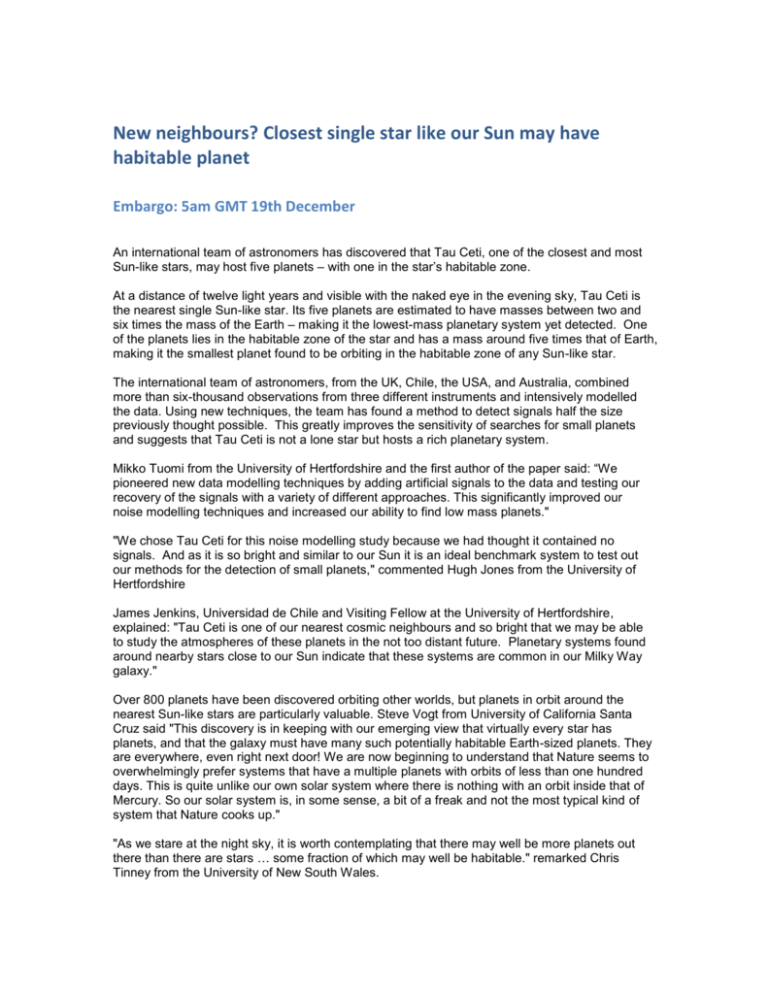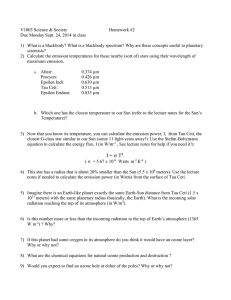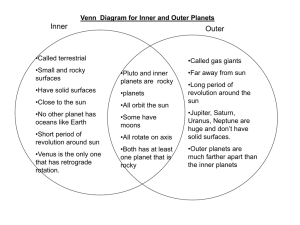Release-tauCeti1.2 - University of Hertfordshire
advertisement

New neighbours? Closest single star like our Sun may have habitable planet Embargo: 5am GMT 19th December An international team of astronomers has discovered that Tau Ceti, one of the closest and most Sun-like stars, may host five planets – with one in the star’s habitable zone. At a distance of twelve light years and visible with the naked eye in the evening sky, Tau Ceti is the nearest single Sun-like star. Its five planets are estimated to have masses between two and six times the mass of the Earth – making it the lowest-mass planetary system yet detected. One of the planets lies in the habitable zone of the star and has a mass around five times that of Earth, making it the smallest planet found to be orbiting in the habitable zone of any Sun-like star. The international team of astronomers, from the UK, Chile, the USA, and Australia, combined more than six-thousand observations from three different instruments and intensively modelled the data. Using new techniques, the team has found a method to detect signals half the size previously thought possible. This greatly improves the sensitivity of searches for small planets and suggests that Tau Ceti is not a lone star but hosts a rich planetary system. Mikko Tuomi from the University of Hertfordshire and the first author of the paper said: “We pioneered new data modelling techniques by adding artificial signals to the data and testing our recovery of the signals with a variety of different approaches. This significantly improved our noise modelling techniques and increased our ability to find low mass planets." "We chose Tau Ceti for this noise modelling study because we had thought it contained no signals. And as it is so bright and similar to our Sun it is an ideal benchmark system to test out our methods for the detection of small planets," commented Hugh Jones from the University of Hertfordshire James Jenkins, Universidad de Chile and Visiting Fellow at the University of Hertfordshire, explained: "Tau Ceti is one of our nearest cosmic neighbours and so bright that we may be able to study the atmospheres of these planets in the not too distant future. Planetary systems found around nearby stars close to our Sun indicate that these systems are common in our Milky Way galaxy." Over 800 planets have been discovered orbiting other worlds, but planets in orbit around the nearest Sun-like stars are particularly valuable. Steve Vogt from University of California Santa Cruz said "This discovery is in keeping with our emerging view that virtually every star has planets, and that the galaxy must have many such potentially habitable Earth-sized planets. They are everywhere, even right next door! We are now beginning to understand that Nature seems to overwhelmingly prefer systems that have a multiple planets with orbits of less than one hundred days. This is quite unlike our own solar system where there is nothing with an orbit inside that of Mercury. So our solar system is, in some sense, a bit of a freak and not the most typical kind of system that Nature cooks up." "As we stare at the night sky, it is worth contemplating that there may well be more planets out there than there are stars … some fraction of which may well be habitable." remarked Chris Tinney from the University of New South Wales. ENDS For more information, please contact Julie Cooper, University of Hertfordshire Press Office on 01707 284095, Email: j.cooper5@herts.ac.uk Mikko Tuomi, University of Hertfordshire, Email miptuom@utu.fi Hugh Jones, University of Hertfordshire, Email h.r.a.jones@herts.ac.uk The paper is accepted for publication in the journal Astronomy & Astrophysics and is available at http://star-www.herts.ac.uk/~hraj/tauceti Images of Tau Ceti are available at http://star-www.herts.ac.uk/~hraj/tauceti including http://star-www.herts.ac.uk/~hraj/tauceti/tau_ceti.jpg Artist’s impression of the Tau Ceti system Picture credit: J. Pinfield for the RoPACS network at the University of Hertfordshire, 2012. http://star-www.herts.ac.uk/~hraj/tauceti/tauceti_niton.jpg This image shows Tau Ceti in the constellation of Cetus taken with an wide angle lens at Niton in the Isle of Wight, UK. Picture credit: D. Campbell for the AllSky camera network at the University of Hertfordshire, 2012 (http://star.herts.ac.uk/allsky/). http://star-www.herts.ac.uk/~hraj/tauceti/stellarium1.jpg Image generated by Stellarium software (http://www.stellarium.org/) showing tau Ceti in the early evening sky in constellation of Cetus on Wednesday 19th December from Hatfield, UK . http://star-www.herts.ac.uk/~hraj/tauceti/cetus-mira100110key.jpg Photograph of the constellation Cetus taken by Jimmy Westlake (http://www.exploresteamboat.com/news/2012/oct/22/jimmy-westlake-sea-monsterfills-eastern-sky/) Notes to Editor The researchers discovered this planetary system using data from three state-of-the-art spectrographs: HARPS on the 3.6m telescope at the European Southern Observatory in La Silla, Chile (4864 data points); UCLES on the Anglo-Australian Telescope in Siding Spring, Australia (978 data points); and HIRES on the 10m Keck telescope on Mauna Kea, Hawaii (567 data points). About the Research Team The international research team consists of Mikko Tuomi who carried out this work while employed on the RoPACS network (coordinated by Dr Pinfield at the University of Hertfordshire), an Initial Training Network funded by the European Commission's Seventh Framework Programme. Hugh Jones, John Barnes and David Pinfield are also supported by the University of Hertfordshire. James Jenkins is based at the University of Chile and is a Visiting Fellow at the University of Hertfordshire. Chris Tinney, Rob Wittenmyer, Jonathan Horner, Jeremy Bailey, Duncan Wright and Graeme Salter (University of New South Wales, Australia) are supported by grants from the Australian Research Council. Steve Vogt from University of California Santa Cruz acknowledges support from NSF grant AST-0307493 Paul Butler is supported by the Carnegie Institution for Science. Simon O'Toole is supported by the Australian Astronomical Observatory. Brad Carter is supported by the University of Southern Queensland The result is based on spectra from taken as part of the Anglo-Australian Planet Search with the UCLES spectrograph on the Anglo-Australian Telescope, HIRES on the Keck Telescope and reanalysis of spectra taken with the HARPS spectrograph and available through the European Southern Observatory public archive. This work would have not been possible without the ESO public data policies and the excellent work of the ESO Software development division and the ESO Science Archive Facility. http://star-www.herts.ac.uk/~hraj/tauceti/tau_ceti.png Artist’s impression of the Tau Ceti system Picture credit: J. Pinfield for the RoPACS network at the University of Hertfordshire, 2012.









